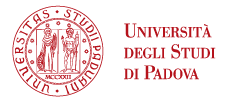Hydrodynamics and Bio-morfodynamics of rivers and lagoons
Andrea Defina – andrea.defina@unipd.it
Stefano Lanzoni – stefano.lanzoni@unipd.it
Luca Carniello - luca.carniello@unipd.it
Daniele Pietro Viero - daniele.viero@unipd.it
Paolo Peruzzo - paolo.peruzzo@unipd.it
Mattia Pivato – mattia.pivato@dicea.unipd.it
Davide Tognin - davide.tognin@phd.unipd.it
Research areas:
The research of the group focuses on the understanding, the monitoring and the mathematical and numerical modelling of the morphological evolution of tidal and fluvial systems, Particular attention is devoted to the interplay between physical and biological processes, as well as to the effects of changes in external forcing due to natural trends (e.g., climate variations) or human pressures.
The research is carried out by combining different approaches, namely field observations, laboratory experiments, mathematical and numerical modelling.
Field measurements are systematically carried out in various rivers (e.g. Piave, Brenta and Bacchiglione) and in the Venice lagoon using suitable sensors (e.g. ADV, ADCP, sediment traps, turbidimeters, temperature sensors etc.). The collected data are then used for identifying the relevant processes, the forcing to be used in laboratory experiments, and for developing, testing and calibrating the models.
The experimental activities take advantage of the flumes, basins and instrumentations available at the Laboratory of Hydraulics and Hydraulic Constructions of the ICEA Department (https://www.dicea.unipd.it/servizi/laboratori/laboratorio-di-idraulica-e...). Examples of laboratory experiments actually ongoing concern: morphodynamics of tidal networks under different tidal forcing (e.g. investigating the role of ebb or flood dominance), sediment characteristics (cohesive and non-cohesive) and scenarios of relative sea level rise; debris flow dynamics; interaction between hydrodynamic and vegetation (e.g. Capillary interception of floating particles by surface-piercing vegetation, bed stabilization induced by halophyte vegetation).
Finally, mathematical and numerical models are continuously developed and updated by the research group and simulate: shallow water hydrodynamics, wind waves generation and propagation, sediment transport of both cohesive and non-cohesive sediments, morphodynamic evolution of riverine and tidal environments, dynamics of passive and active scalars (e.g., temperature, nutrients), water age.





